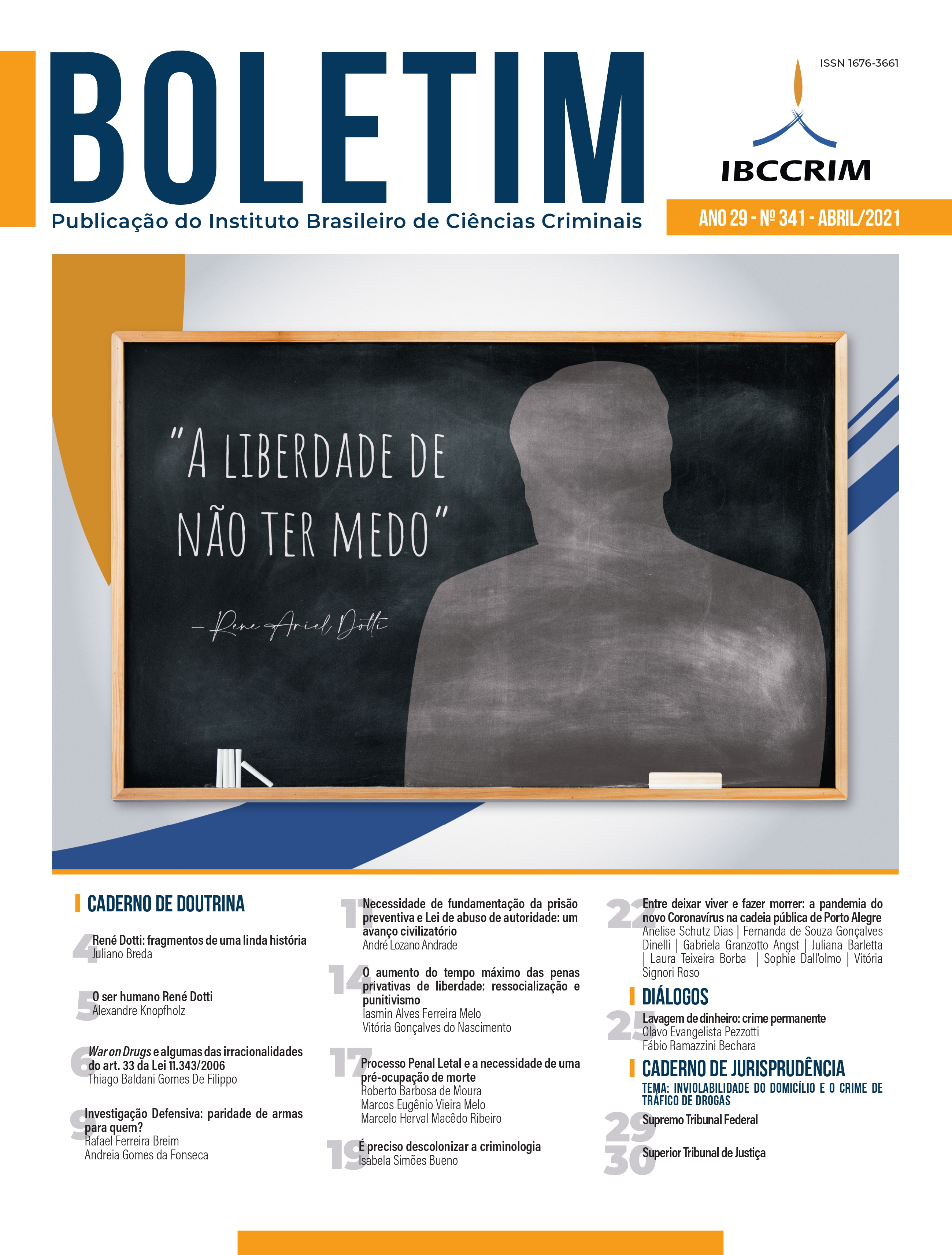The increase on maximum penalties’ limit: resocialization and punitivism
Views: 304Keywords:
Human Dignity, Brazilian Criminal Code, ‘Pacote Anticrime’Abstract
The Law number 13.964/19 altered the article 75 of the Brazilian Criminal Code, raising the maximum penalty of custodial sentences in 10 years, fixing it in 40 years in spite of the current prisons’ conditions in Brazil. This article intends to analise the intercourse between the raise in the maximum penalty and human dignity, under the perspective of constitutional and general principles of criminal law, interrelating the discussion with the prohibition of life sentences, the infrastructure of Brazilian prisons and resocialization. Considering these factors, it is noted that the raise in custodial sentences without changes in the penitentiary structure go against the constitutional principle of human dignity, besides mitigating the resocializing goal of custody, fundamental aspects in the context of discussions about brazilian’s penal system.
Downloads
Publication Facts
Reviewer profiles N/A
Author statements
- Academic society
- Instituto Brasileiro de Ciências Criminais
- Publisher
- IBCCRIM
References
ALIGHIERI, Dante. A Divina Comédia. Belo Horizonte: Ed. Itatiaia; São Paulo: EDUSP, 1979.
BRASIL. [Constituição (1988)]. Constituição da República Federativa do Brasil. Brasília: Senado Federal, 1988.
BRASIL. Decreto-Lei 2.848, de 07 de dezembro de 1940. Código Penal. Diário Oficial da União: Rio de Janeiro, 31 dez. 1940.
BRASIL. Lei 8.072 de 25 de julho de 1990. Brasília, DF: Câmara dos Deputados, [1990]. Disponível em: https://www2.camara.leg.br/legin/fed/lei/1990/lei-8072-25-julho-1990-372192-exposicaodemotivos-150379-pl.html. Acesso em: 25 de mar. 2020.
BRASIL. Lei de execução Penal, Lei nº 7210/84. Diário Oficial da União: Brasília, DF, 11 jul. 1984.
BRASIL. Instituto de Pesquisa Econômica Aplicada (Ipea). Atlas da Violência, 2020. Homicídios. [s. l.], 2020. Dispinivel em: https://www.ipea.gov.br/atlasviolencia/dados-series/17. Acesso em: 24 set. 2020.
BRASIL. Superior Tribunal de Justiça. ADPF 347 MC/DF. Plenário. Relator: Ministro Marco Aurélio. DJe: Brasília, DF, 9 set. 2015. Disponível em: http://redir.stf.jus.br/paginadorpub/paginador.jsp?docTP=TP&docID=10300665. Acesso em: 14 mar. 2020.
BRASIL. Congresso Nacional. Projeto de Lei nº 10.372/18. Plenário. Relator: Deputado Lafayette de Andrada. Transformado na Lei Ordinária 13.964/2019. Brasília, DF: Câmara dos Deputados, [2019]. Disponível em: https://www.camara.leg.br/proposicoesWeb/fichadetramitacao?idProposicao=2178170. Acesso em:15 mar. 2020.
BRASIL. Ministério da Justiça e Segurança Pública. INFOPEN. Levantamento nacional de informações penitenciárias: Atualização – junho de 2016. Brasília, DF: MJSP, 2017. Disponível em: file:///C:/Users/PMSP%20-%20V%C3%ADdeo/Downloads/Infopen-jun-2016.pdf. Acesso em: 12 mar. 2020.
CASTILHO, Ricardo. Direitos humanos. 4. ed. São Paulo: Saraiva, 2017.
CLEMMER, Donald. The prison community. New York: Holt, Rinehart and Winston, 1958.
COELHO, Edmundo C. A oficina do diabo – e outros estudos sobre criminalidade. Rio de Janeiro: Record. 2005.
FOUCAULT, Michel. Vigiar e punir: nascimento da prisão. 42. ed. Petrópolis: Vozes, 2014.
GRECO, Rogério. Curso de Direito Penal: Parte Geral. 4. ed. Rio de Janeiro: Impetus, v.1, 2011.
JAKOBS, Günther; MELIÁ, Manuel Cancio. Direito Penal do Inimigo: Noções e críticas. 6. ed. Porto Alegre: Livraria do Advogado, 2012.
LAPPI-SEPPÄLÄ, Tapio. Trust, Welfare, and Political Culture: Explaining Differences in National Penal Policies. Crime and Justice, Chicago, v. 37, n.1, p. 313-387, 2008.
LOPES JR, Aury. Fundamentos do Processo Penal: Introdução Crítica. 2. ed. São Paulo: Saraiva, 2016.
LYRA, Roberto. "O Novo Direito Penal". Rio de Janeiro: Editor Borsoi, 1971.
RIBEIRO, Bruno de Morais. Revalorização das penas privativas curtas: instrumento para a redução da intervenção penal. Revista Meritum, Belo Horizonte, v. 2, n. 1, p. 85-108, jan./jun. 2007.
SNYDER, Cindy; WORMER, Katherine van; CHADHA, Janice; JAGGERS, Jeremiah W. Older Adult Inmates: The Challenge for Social Work. Social Work, v. 54, n. 2, p. 117-124, abr. 2009.
Downloads
Published
How to Cite
Issue
Section
License
Copyright of published articles belongs to the author, but with journal rights over the first publication and respecting the one-year exclusivity period. Authors may only use the same results in other publications by clearly indicating this journal as the medium of the original publication. If there is no such indication, it will be considered a situation of self-plagiarism.
Therefore, the reproduction, total or partial, of the articles published here is subject to the express mention of the origin of its publication in this journal, citing the volume and number of this publication. For legal purposes, the source of the original publication must be consigned, in addition to the DOI link for cross-reference (if any).


 Português (Brasil)
Português (Brasil)
 English
English
 Español (España)
Español (España)






